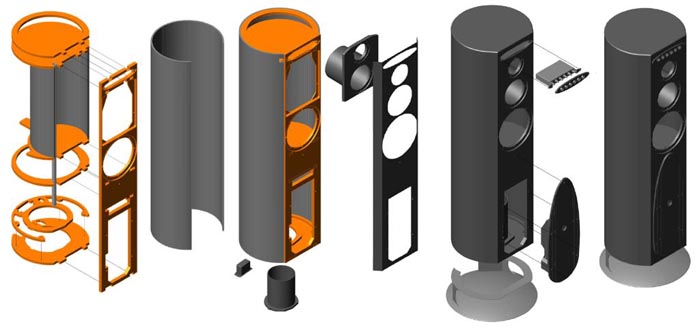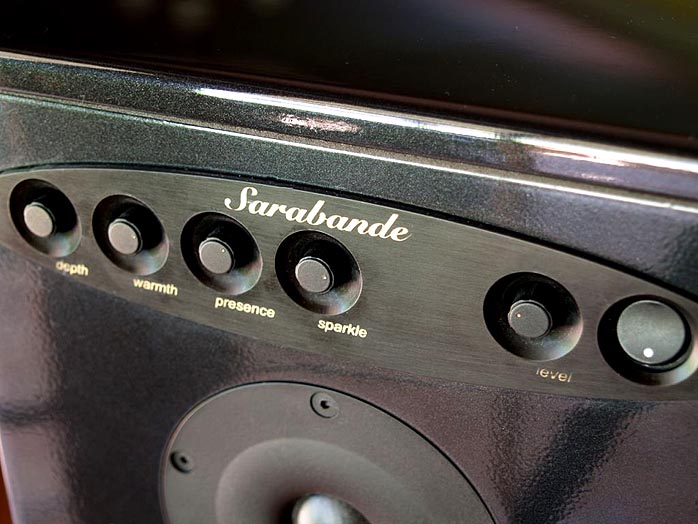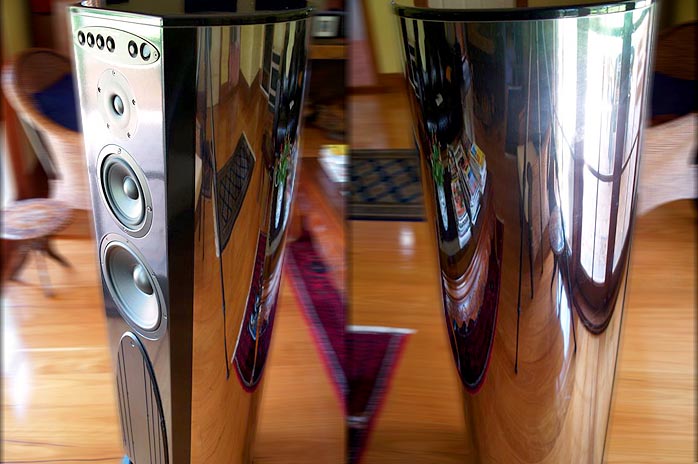|
|
|
|
|
This review page is supported in part by the sponsors whose ad banners are displayed below
|
|
 |
|
The subject of this review is the Sarabande in standard guise which is anything but standard. Nevertheless, you're looking at a rather large floor-standing fully active speaker that includes a front-firing 1-inch silk tweeter, a 5-inch midrange driver, an 8-inch lower midrange/upper bass driver (both polypropylene) and two internal "compound cavity drive" 12-inch paper woofers firing face to face and out through a large port on the speaker's base. The enclosure is constructed from a high-density composite cellulose substrate, which is a wound recyclable cardboard material and extremely strong. A layer of latex compound is then affixed between the substrate and the stainless-steel outer skin to make for a dense sandwich which provides outstanding resonance damping and utter solidity (up to seven times stronger than a rectangular box).
|
|
 |
|
The 40kg enclosure is tubular in shape, ported at the base and sliced on one side as to fit the layered 12 - 24mm baffle holding the front-firing drivers. The construction can subsequently be veneered and painted in a number of colors and finishes. The review sample was provided in a chromed metal finish with dark gloss gray baffle. The four 100-watt amplifiers are attached to a massively built and front-mounted aluminium plate that allows easy access for servicing. Cunningly, this nicely-finished semi-elliptical plate doubles as a curvy accent to the front baffle. A very unusual feature is the adjustable electronic crossover, again neatly mounted on the front baffle just above the tweeter. The crossover points are claimed to be defined by the speaker components and specified at 100Hz, 560Hz and 5kHz.
|
|
 |
|
|
John is a firm believer in speakers that can be efficiently integrated into the listening environment, their sound easily tailored by the user. To this end, the electronic crossover includes several controls that can literally transform the speaker to suit any taste and room. From left to right, there is +/- 6dB of deep bass control via the depth control, mid-bass via the warmth, midrange palpability and perspective via the presence and top-end extension and detail via the sparkle control. There's a gain control for easy matching to any preamplifier and of course, an on/off switch for the in-built amplifiers. For specs, we have a frequency response spanning a usefully low 30Hz to 20kHz (no tolerances given). Input impedance of the built-in amplifiers is 10Kohm on either RCA or XLR inputs. With the amplification being perfectly matched to each driver, power rating figures become obsolete. This is one indestructible speaker. Just crank it and see.
|
|
|
|
I did mention earlier that this was the standard Sarabande. Lenard Audio is quite happy to create custom versions and plans are on the drawing board for Sarabande 'The Audiophile'. We be talkin' bespoke drivers from the best of the Danes and hand-built valve amplification with 'glowing-bulb' configurations perfectly mated to each driver.
|
|
 |
|
|
Tango and other Tangles
Listening tests for review purposes were conducted with all the crossover/equalizer settings at 12 o'clock, the neutral position. When conducting boogie-woogie listening, I found myself tweaking all controls to 2 o'clock. More is better!
A disc that is on regular spin chez Kramer is Tango Jam [Mulberry Hill Recordings MHR-C001]. As said in a previous review: "One of my all-time favorite CDs, and one that I would take to that imaginary island of the lonely audiophiles, is our own ACO's (Australian Chamber Orchestra, arguably the best chamber ensemble in the world) interpretation of some of Astor Piazzolla's most intoxicating tango masterpieces - Tango Jam. This writer was lucky enough to be in a prime listening position at the Sydney Opera House when this extraordinary music was performed by maestro Richard Tognetti and his group of outstanding musicians [James Crabb (classical accordion), Benjamin Martin (piano), Maxime Bibeau (double bass) and George Vassilev (guitar)]."
For this review in particular, this wondrous recording was that much more significant due to the fact that the ACO's Artistic Director, Richard Togneti, just happens to have a pair of Sarabandes in his home system. How very appropriate.
|
|
|
|
|
 |
|
|
 |
|
 |
|
|
|
|
|
|
|